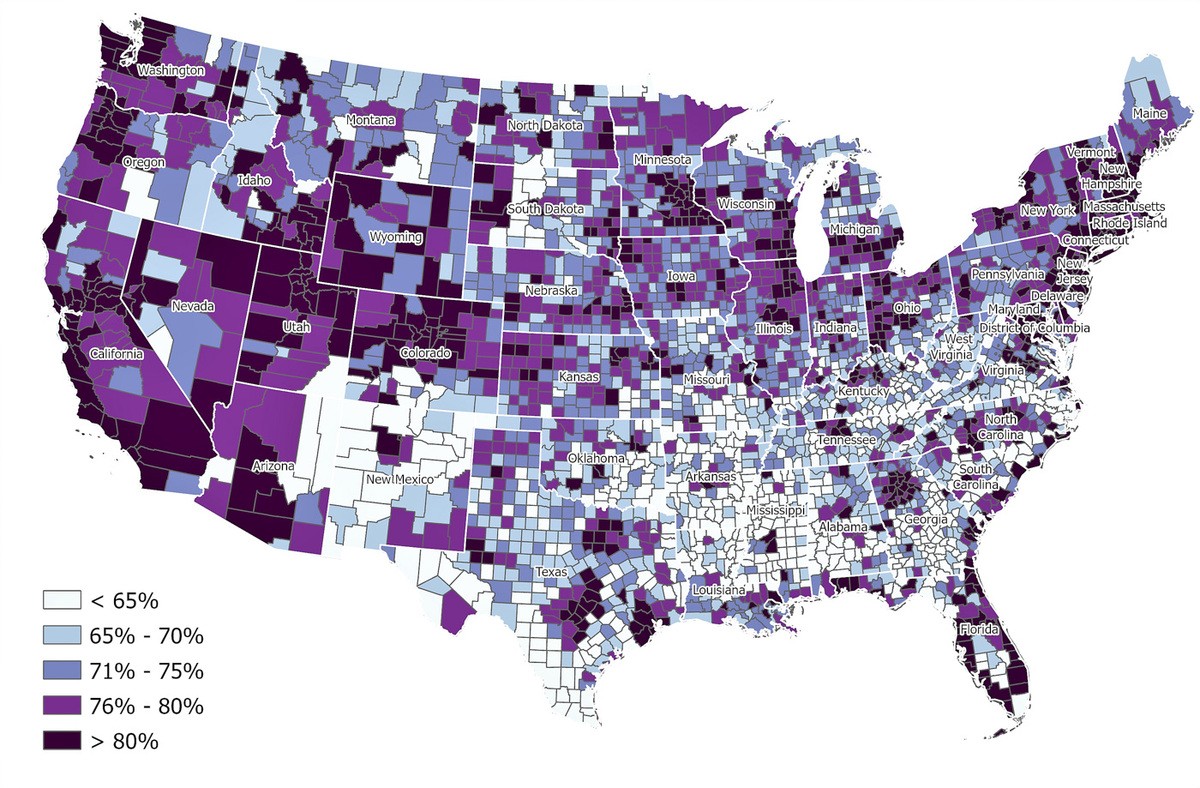
Residents in 'digital deserts' have fewer health care options
UC epidemiologist says disparities in health care could get worse as more services go online
Residents in rural counties with limited access to high-speed internet cannot take advantage of increasingly popular online health services.
A new study by the University of Cincinnati highlighted disparities in access to digital technology that could widen the gap in access to health care. The study found that socially vulnerable communities in the United States face more barriers to adequate health care, live in areas with fewer health care resources and have less access to high-speed internet.
The study was published in the journal Mayo Clinic Proceedings: Digital Health.
The Biden administration announced this year it will invest $73 million in outreach grants to provide affordable high-speed internet to more Americans. The program is designed to address a growing gap in access to health care created during the COVID-19 pandemic when providers began offering more health care services over the web.
UC researchers conducted a county-level analysis that identified disparities in health care and high-speed internet access in the contiguous United States.
Study author and UC epidemiologist Diego Cuadros said patients need access to high-speed internet, computers or smart phones and familiarity with technology to use these systems comfortably so they can take advantage of the growing shift to telemedicine and online health services.
The study found that counties with the highest broadband access also had the strongest health care systems, lowest barriers to health care access and lowest social vulnerability.

High-speed internet coverage in the contiguous United States by county. White areas illustrate counties with broadband coverage less than 65% of the population. Darker purple areas illustrate the counties with more than 80% broadband coverage.
Cuadros, an associate professor in UC’s College of Arts and Sciences, runs UC’s Digital Epidemiology Laboratory.
His previous research found disparities in easy access to health care across the United States. Many of these same areas have limited access to digital technology such as high-speed internet.
“This finding emphasizes the role that broadband access plays in accessing health care services, particularly during times like the COVID-19 pandemic,” Cuadros said.
“Patients in areas with low broadband access may face greater challenges in obtaining timely and convenient healthcare, leading to potential delays in diagnosis, treatment, and overall healthcare outcomes.”
The study underscores the need for policymakers and health care leaders to prioritize efforts to improve broadband infrastructure, digital literacy and affordability to ensure equitable access to healthcare services for all patients.
Diego Cuadros, UC's Digital Epidemiology Lab
A vast majority of counties with low broadband access and limited access to health care and social services were rural. About 21 million people, including 14 million rural Americans and more than 1 million Americans living on tribal lands, lack broadband access.
“Telehealth has an awful lot of merit, but the challenge is that telehealth assumes that a person has access to high-speed internet,” said study co-author Neil MacKinnon, provost for Augusta University.
“If someone doesn’t have that access, it can make it difficult for patients and doctors alike. This study shows that because of the digital desert concept, the technology divide really could have health consequences by contributing to a greater health divide in the country.”
University of Washington assistant professor of physiology and biophysics Claudia Moreno, F. DeWolfe Miller at the University of Hawaii, Honolulu, and Ryosuke Omori at Hokkaido University also co-authored the study.
“The study underscores the need for policymakers and health care leaders to prioritize efforts to improve broadband infrastructure, digital literacy and affordability to ensure equitable access to healthcare services for all patients,” Cuadros said.
While the United States is a global telecommunications leader, it does not even crack a list of the top 20 nations in terms of per capita wireless coverage, according to a 2023 Statista survey. That’s largely because it’s a large country in square miles, Moreno said.
“What was surprising was to see the strong correlation between the lack of broadband access and the socioeconomic and health care vulnerability of some regions,” Moreno said. “This association suggests that broadband coverage can act as an institutionalized inequity that needs to be addressed to help vulnerable communities.”
Moreno said while the pandemic served as a catalyst that pushed many people to adopt new ways of doing things, not everyone has made the same digital transition.
“The reality is that not everyone was thrilled with that option. Accessing telehealth is challenging for people that are not digitally literate or for people who do not own a smartphone or a computer,” she said. “Telehealth has a huge potential to help vulnerable communities, but if we really want to exploit this potential, the country needs to create policies and programs that increase access within these communities.”
Featured image at top: University of Cincinnati epidemiologist Diego Cuadros says the lack of available broadband internet in some parts of the United States will lead to gaps in health care access. Photo/iStockPhoto
Next Lives Here
The University of Cincinnati is classified as a Research 1 institution by the Carnegie Commission and is ranked in the National Science Foundation's Top-35 public research universities. UC's graduate students and faculty investigate problems and innovate solutions with real-world impact. Next Lives Here.
Related Stories
Forbes Under 30 Summit showcases Cincinnati’s entrepreneurial spirit
September 26, 2024
Young talent from across America gathered in Cincinnati to gain insights from esteemed business leaders and discover the Queen City’s vibrant entertainment and business scenes.
Knowledge Nexus aims to empower new faculty with research capabilities
September 26, 2024
Knowledge Nexus is a series of workshops—presented in partnership with the University of Cincinnati's Associate Dean of Education Innovations and Community Partnerships and Associate Dean of Academic Affairs (Dean’s Office, CECH)—that outline common intricacies of research development at CECH and UC, which, as an R1 institution, absolutely values research activity.
UC professor feels need for speed
September 26, 2024
The world's largest aerospace group named UC Professor Prashant Khare an associate fellow. He is studying hypersonic flight in his aerospace engineering lab.
Founders + Funders Summit brings business talent to Cincinnati
September 26, 2024
Entrepreneurs and business titans alike headed to the University of Cincinnati’s 1819 Innovation Hub for the Founders + Funders Summit, which highlighted the region’s corporate prestige and provided insights for Cincinnati’s startup community.
Is your garden in need of drought relief?
September 26, 2024
UC Professor Theresa Culley takes listener questions about gardening and the drought on WVXU's Cincinnati Edition.
Hoxworth honors community heroes
September 26, 2024
Hoxworth Blood Center, University of Cincinnati, is encouraging the Greater Cincinnati community to roll up their sleeves and save lives this October. In recognition of National Heroes Day on Oct. 8 and the generosity from community donors, all blood and platelet donors who give at any Hoxworth Neighborhood Donor Center or select mobile blood drives during the month of October will receive an exclusive, limited-edition long sleeve hooded shirt featuring the powerful message, Blood Donors Save Lives, while supplies last.
Hoxworth Blood Center launches Pucks for Platelets to celebrate Cincinnati’s lifesaving heroes
September 26, 2024
Hoxworth Blood Center is partnering with the Cincinnati Cyclones to honor Cincinnati’s most dedicated platelet donors with an exclusive experience called Pucks for Platelets. The initiative aims to recognize and celebrate the lifesaving contributions of platelet donors, who help to ensure the survival of patients battling cancer, trauma and other life-threatening conditions in local hospitals.
Styrene and its health, environmental impacts
September 25, 2024
A chemical leak from a train car in Hamilton County led to evacuations. UC experts are sharing what is styrene and offer a look at the health and environmental impacts.
How to use monoclonal antibodies for migraine in primary care
September 25, 2024
The University of Cincinnati's Vincent Martin told Medscape that every primary care clinician should know about monoclonal antibodies for preventing migraines that are changing the lives of patients.
This UC student’s love of criminal justice led her to study in Scotland
September 25, 2024
Gaby Ramos, a student in the University of Cincinnati's Criminal Justice program (part of the College of Education, Criminal Justice, Human Services, and Information Technology), has plans to become a criminal attorney in the future and recently took her passion for criminal justice overseas with a study abroad trip to Scotland.
